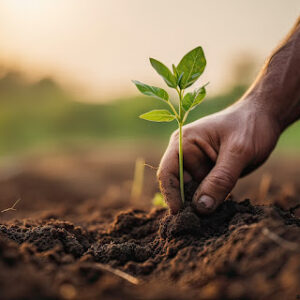
- +254708120315
- vikimsolutions@gmail.com
- Nairobi, Kenya
Sustainable agriculture is an essential aspect of environmental management that seeks to develop productive, profitable, and environmentally sound farming that minimizes the detrimental impact of farming activities on the natural environment and people. This is a strategy devised to ensure that the human need of the present generation is fulfilled in such a way that similar need of the next generation is also met. Sustainable agriculture incorporates different strategies and principles of agricultural production involving sustainable approaches that help to sustain soil fertility, water conservation minimizing greenhouse gas emissions, and supporting biological diversity.
Cropping three or four crops that is crop under one piece of land is one of the most important key practices sustainable farmers put into practice. This can easily be achieved through crop rotation where farmers plant distinct varieties of crops in different seasons to enhance the soil qualities, and space and minimize pests and diseases. For example, if farmers use a technique of crop rotation, where legume crops are followed by cereal crops, the levels of soil nitrogen will build up on their own because legumes have natural ability to fix nitrogen from the atmosphere. This cuts down the use of chemical fertilizers which if used can have dangerous impacts on the biosphere.
Another method in conservation tillage is what is referred to as cover crops, crops like clovers or rye are planted on the soil for the purpose of covering them instead of being harvested. These cover crops assist in acting as a protective cover to prevent erosion, remain as weed suppressants, and boost the fertility of the soil by adding organic matter. These can boost fertility and the tilt of the soil and create uniform water distribution when mixed with crops, hence improving crop production and reducing the use of Artificial fertilizers.
This is known as the Agroforestry system where trees and shrubs are planted together with crops and livestock in the farming systems. Some of the roles include use of trees in protecting stature against winds, assisting in checking soil erosion or improving water infiltration. They also provide shelter for the beneficial insects and wildlife and this has the effect of managing the pest in the garden. Also, agroforestry systems may contribute to reducing risks of income diversification on farms by supplementing other sources of income from timber, fruits, nuts, etc.
Conservation tillage incorporates measure that reduces the degree of soil turnover. Main benefits include: conservation tillage minimizes soil disturbance and promotes soil structure, curbing soil erosion, and water retention where plowing is minimized or done away with. This practice also encourages the growth of desirable Micro fauna in the soil, such as bacteria and earthworms that contribute to improving the fertility of the soil and general status of the soil. The only type of tillage is conservation tillage, which is sowing seeds straight into the ground without turning the soil over; this reduces the energy used in cultivation.
Integrated Pest Management (IPM) is the use of pest management techniques that require the application of interdisciplinary and environmentally sound principles and practices that are economically sustainable. According to IPM, biological predators, crop interchange, and resistant types of crops are the main methods of controlling pests. Every type of chemical pesticide is used as a last resort and strictly applied to selected areas so as not to harm the whole environment and at the same time not contribute to the building up of pesticide resistance.
Organic farming for that matter is a technique of farming that eliminates the use of synthetic fertilizers and pesticides since it aims at natural methods only. The types of inputs in organic farming include compost, animal manure, and green manure for improving the fertility of the soils. They also use practices such as crop rotation, the use of a usually sowed cover crop, and the use of bio-control methods to check on pests and sicknesses. Organic farming is a useful technique that can lead to better soil conditions, diversity in the ecosystem, and the minimum hazards of pollution of water bodies due to runoff in agricultural fields.
Agriculture needs water very much and due to the limited supply of water, water management is very important for sustainable agriculture production. Some of the approaches include water conservation whereby water is only used in the recommended amounts such as by use of techniques like drip irrigation as well as the use of rainfall harvesting techniques. Drip irrigation is a water delivery system that supplies water straight to the roots, thus avoiding wastage through evaporation and surplus drainage. Rainwater harvesting involves the provision of water storage structures to collect water during the rainy season so that water can be obtained during the dry season without the need to use water from wells, lakes, or other water bodies.
Another aspect that needs to be explained is that sustainable practices regarding livestock management are also needed to prevent further deterioration of the surroundings. Rotational grazing is another method that involves transferring the animals from one paddock to another so as to allow the pastures to rest and grow back while reducing the density of animals on the ground. This practice can increase the rates of pasture production, boost animal welfare, and decrease the utilization of compensated feeds. Furthermore, the successful integration of animals into crop production leads to a less-input-dependent system since wastes generated by animals can be used to replenish soil nutrients and crop residues can be used in feeding the animals.
Since sustainable agriculture forms the foundation of AU-IBAR’s interventions, soil fertility management is fundamental in the organization. The best way to ensure healthy soils is by incorporating organic much, crop rotation, and cover cropping. By composting, organic matter that may otherwise harm the environment is recycled forming soil conditioners that enhance the physical and chemical characteristics of the soil and also soil microorganisms. Once in a while, the amount and type of nutrients applied to the crop is over resulting in amendments that pollute the water resources hence supporting the farmers to apply the right amounts and type of nutrients.
Sustainability is another important feature of the diversified agriculture system, and that is why the concept of biodiversity became very popular. Integrated farmer activity systems are better placed to counter pests, and diseases, and have the flexibility to climatic change. The introgressive cultivation of crops is known as poly culture, and it helps in the increase of large from of bio-diversity and also reduces the risks of gazette crop failure. Use of hedge rows and buffer strips created from native plants offers shelter to helpful insects and wildlife which offer predator control on pests and aid in pollination.
Climate-smart agriculture (CSA) practices consist of practices that increase yields and other production measures or increase production measures while also reducing Greenhouse Gas emissions. CSA practices include a choice of appropriate crop varieties, especially those that can withstand dry spells, watering techniques, and planting of trees in farming. They also address the possibility of managing the shocks of climate change and at the same time reducing their occurrence.
Farm management is another important aspect in the business of farming and more so in sustainable agriculture. Farmers need incentives to adopt these practices since the practices must be economically beneficial for farmers. Possible solutions include an increase in farm income through growing a diversity of products including through agroforestry practices, organic production, and through diversifying farm output by adding more value to the final produce. Besides, markets, fair trade, and supportive policies are crucial for increasing productivity and consequently the sustainability of extending agricultural systems.




Copyright © 2024 Vikim Solutions. All rights reserved.
105 Responses
Thanks a lot for taking the time to share such valuable insights. It’s always great to get fresh perspectives on important topics like this.
Your writing style is captivating; I never get bored perusing your articles.
перепродажа аккаунтов маркетплейс аккаунтов
маркетплейс аккаунтов https://marketplace-akkauntov-top.ru/
аккаунты с балансом платформа для покупки аккаунтов
маркетплейс аккаунтов маркетплейс аккаунтов
аккаунт для рекламы маркетплейс аккаунтов соцсетей
покупка аккаунтов https://pokupka-akkauntov-online.ru
Ready-Made Accounts for Sale Online Account Store
Sell Account Buy Pre-made Account
Buy Account Sell Pre-made Account
Account Catalog Account Purchase
Find Accounts for Sale Online Account Store
Accounts market Accounts marketplace
Account Selling Service Account Catalog
Buy Pre-made Account Account marketplace
Account Trading Service Account Buying Platform
Website for Buying Accounts Account Market
buy pre-made account buy account
secure account purchasing platform secure account purchasing platform
account sale account sale
marketplace for ready-made accounts https://buyaccountsdiscount.com
website for selling accounts account store
account trading account trading service
online account store secure account sales
account exchange account trading service
find accounts for sale account selling service
secure account sales account market
find accounts for sale account acquisition
accounts for sale online account store
buy pre-made account database of accounts for sale
database of accounts for sale account selling service
profitable account sales website for buying accounts
accounts market account purchase
account trading platform account exchange
verified accounts for sale website for buying accounts
verified accounts for sale account trading service
accounts for sale sell pre-made account
account trading account buying service
profitable account sales website for buying accounts
account trading platform sale-social-accounts.org
account buying platform profitable account sales
account exchange service database of accounts for sale
account selling service account buying platform
secure account sales online account store
account sale https://accounts-offer.org/
account store https://accounts-marketplace.xyz
purchase ready-made accounts https://accounts-marketplace.live/
account store https://social-accounts-marketplace.xyz/
account selling service https://buy-accounts.space
accounts marketplace https://buy-accounts-shop.pro
social media account marketplace https://buy-accounts.live
account sale https://accounts-marketplace.online
sell accounts https://social-accounts-marketplace.live
account store https://accounts-marketplace-best.pro/
купить аккаунт https://akkaunty-na-prodazhu.pro
маркетплейс аккаунтов https://rynok-akkauntov.top/
магазин аккаунтов https://kupit-akkaunt.xyz
магазин аккаунтов https://akkaunt-magazin.online/
покупка аккаунтов akkaunty-market.live
площадка для продажи аккаунтов https://kupit-akkaunty-market.xyz
продажа аккаунтов https://akkaunty-optom.live
продажа аккаунтов online-akkaunty-magazin.xyz
биржа аккаунтов https://akkaunty-dlya-prodazhi.pro
продажа аккаунтов https://kupit-akkaunt.online/
buy facebook ads accounts https://buy-adsaccounts.work
facebook accounts to buy https://buy-ad-accounts.click
buy facebook profile facebook ad accounts for sale
buy facebook ads manager buy facebook accounts
facebook ad account buy https://ad-account-buy.top
facebook ad accounts for sale buy facebook ad account
cheap facebook account https://ad-account-for-sale.top
facebook accounts to buy https://buy-ad-account.click/
buy facebook old accounts https://ad-accounts-for-sale.work
google ads account for sale google ads account buy
buy google ads accounts https://buy-ads-accounts.click/
cheap facebook account facebook ad accounts for sale
google ads agency accounts https://ads-account-for-sale.top
old google ads account for sale https://ads-account-buy.work
adwords account for sale buy verified google ads accounts
buy google ads threshold account https://buy-account-ads.work/
buy google ads threshold accounts https://buy-ads-agency-account.top/
adwords account for sale https://sell-ads-account.click
buy google ad threshold account google ads agency account buy
buy business manager facebook verified business manager for sale
buy google ads google ads account seller
buy facebook business account buy-bm-account.org
facebook business manager buy https://buy-verified-business-manager-account.org/
buy verified facebook business manager account https://buy-verified-business-manager.org
buy facebook business account buy facebook bm
buy verified business manager https://business-manager-for-sale.org
buy verified business manager https://buy-business-manager-verified.org/
buy verified facebook business manager https://buy-bm.org
verified business manager for sale buy-business-manager-accounts.org
tiktok ads account buy https://buy-tiktok-ads-account.org
buy verified facebook business manager https://verified-business-manager-for-sale.org/
buy tiktok ads accounts https://tiktok-ads-account-buy.org
tiktok ads account for sale https://tiktok-ads-account-for-sale.org
buy tiktok ads account https://tiktok-agency-account-for-sale.org
tiktok ads account for sale https://buy-tiktok-ad-account.org
tiktok ads agency account https://buy-tiktok-ads-accounts.org
tiktok agency account for sale https://tiktok-ads-agency-account.org
tiktok ads account for sale https://buy-tiktok-business-account.org
tiktok ad accounts https://buy-tiktok-ads.org
Thank you for your sharing. I am worried that I lack creative ideas. It is your article that makes me full of hope. Thank you. But, I have a question, can you help me?